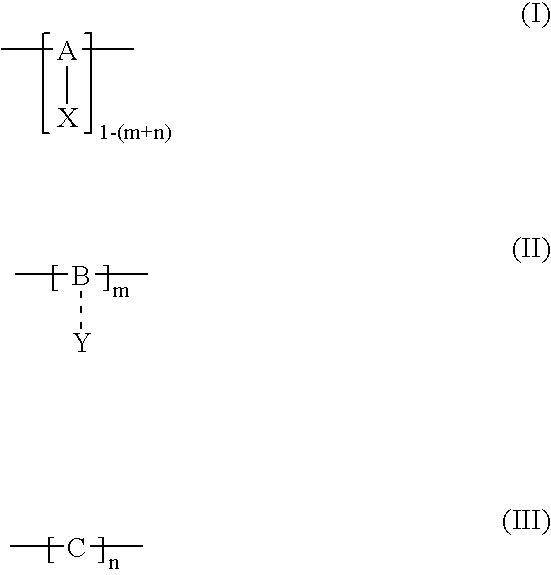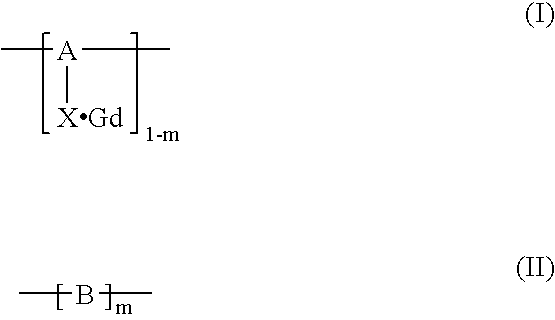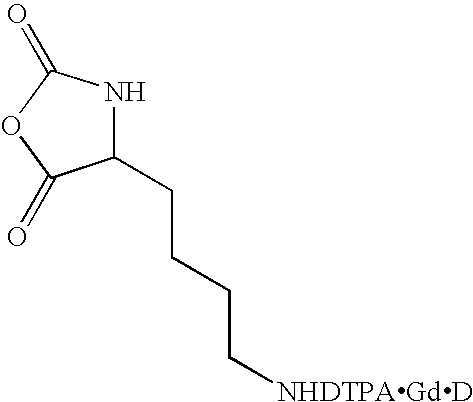Polymerization method for the synthesis of polypeptide imaging agents
a polypeptide and imaging agent technology, applied in the field of magnetic resonance imaging, can solve the problems of difficult to synthesize reliably high-conjugated polymers, unable to deliver a large number of contrast-enhancing ions, and tend to rapidly clear away from the body, so as to achieve the effect of increasing the conjugation of polymers
- Summary
- Abstract
- Description
- Claims
- Application Information
AI Technical Summary
Benefits of technology
Problems solved by technology
Method used
Image
Examples
example 1
Synthesis of Lysine-Nε-DTPA 5
(A) Synthesis of 9-BBN-lysine complex, 3, depicted in Scheme 1.
[0085]
[0086]A sample of lysine, 1, (1 eq) is stirred in MeOH (0.03M solution) at ambient temperature. An aliquot of a solution of 9-borobicyclononane (9-BBN) (1 eq), 2, in tetrahydrofuran (THF) is introduced by syringe, and the cloudy reaction mixture is stirred under refluxing conditions (˜50° C.) over 1 hour to give a clear colorless solution. The volatile organic solvents are removed under reduced pressure to give a solid that is then redissolved in warm (˜40° C.) THF and filtered to provide a colorless solution. The solution is filtered and the volatiles are removed in vacuo to afford 9-BBN-lysine, 3, as an off white solid, which is then washed with pentanes, dried in vacuo and used without further purification.
(B) Synthesis of 9-BBN-lysine-DTPA, 4, depicted in Scheme 2.
[0087]
[0088]A sample of DTPA (1 eq) is added to a solution of acetonitrile (CH3CN, 0.1 M), followed by the addition of t...
example 2
Alternate Synthesis of Lysine-Nε-DTPA 5
[0090]To a CH3CN solution (0.1M) is added DTPA (1 eq) and triethylamine (NEt3) (5 eq) to provide a cloudy solution that is then degassed for 20 mins before stirring at 55° C. for 1 hour. The resulting clear colorless solution is then cooled to −45° C. and isobutylchlorofomate (IBCF) (1.1 eq.) added dropwise over the course of about 20 minutes and stirred for 1 hour at −45° C. to give a white slurry. The slurry is then added to a clear dimethylformamide (DMF) solution of Nα-Boc-lysine (1 eq) and N-methylmorpholine (2 eq) followed by stirring at ambient temperature for 12 hours. The reaction mixture is then treated with acetylchloride (9 eq) in MeOH (0.1M) for 6 hours at ambient temperature at which point the volatiles are removed to afford a residue that is treated with NaOH (6 eq) in MeOH (0.1M) for 6 hrs. The volatiles are removed in vacuo and the resulting residue is purified by reversed phase silica gel chromatography to isolate lysine-Nε-DT...
example 3
Synthesis of Lysine-Nε-DTPA.Gd.Na 6, Depicted in Scheme 3
[0091]A sample of lysine-Nε-DTPA 5 (1 eq) from Example 1 or Example 2 is dissolved in H2O to form a 0.1M solution, which is added to a pH 6 buffer solution of GdCl3 (1.2 eq) and trisodium citrate (2.4 eq). The reaction mixture is stirred for 12 hours, the volume reduced under centrifugal vacuum and then twice passed through a Sephadex plug. The volume is reduced under centrifugal vacuum and then the reaction mixture is added to acetone (5 eq by volume). A white solid containing the product, lysine-Nε-DTPAGd.Na 6 precipitates, and the product 6 is isolated by filtration, followed by washing with acetone (3×10 mL) and drying in vacuo.
[0092]
PUM
| Property | Measurement | Unit |
|---|---|---|
| temperature | aaaaa | aaaaa |
| temperature | aaaaa | aaaaa |
| temperature | aaaaa | aaaaa |
Abstract
Description
Claims
Application Information
 Login to View More
Login to View More - R&D
- Intellectual Property
- Life Sciences
- Materials
- Tech Scout
- Unparalleled Data Quality
- Higher Quality Content
- 60% Fewer Hallucinations
Browse by: Latest US Patents, China's latest patents, Technical Efficacy Thesaurus, Application Domain, Technology Topic, Popular Technical Reports.
© 2025 PatSnap. All rights reserved.Legal|Privacy policy|Modern Slavery Act Transparency Statement|Sitemap|About US| Contact US: help@patsnap.com



